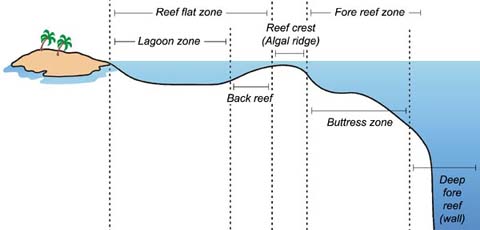Coral Reef Cross Section

Over time, many coral reefs develop similar biogeographic profiles. Moving seaward from the shore, the reef flat, reef crest, buttress zone and seaward slope form the major divisions common to most reefs. The reef flat is on the sheltered side of the reef. The substrate is formed of coral rock and loose sand, and large parts may be exposed during low tides. The reef crest, or algal ridge, is the highest point of the reef, and is almost always exposed at low tide. The reef crest is exposed to the full fury of incoming waves, and living corals are practically nonexistent here. Small crabs, shrimps, and other animals often live in the cavities under the reef crest, protected from waves and predators.
The buttress zone is a rugged area of spurs, or buttresses, radiating out from the reef. Deep channels that slope down the reef face are interspersed between the buttresses. The buttress zone acts to dissipate the tremendous force of unabating waves and stabilizes the reef structure. The buttress zone also drains debris and sediment off the reef and into deeper water. The dropoff of a reef slope can extend hundreds of feet downward. While light intensity decreases, reduced wave action allows greater numbers of coral species to develop. Sponges, sea whips, sea fans, and non-reef-building corals become abundant and gradually replace stony corals in deeper, darker water.
 Deep Sea Crabs
Deep Sea Crabs